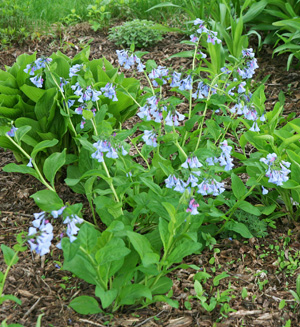Bloodroot (Sanguinaria Canadensis)
Bloodroot, one of the earliest Spring Wildflowers
Bloodroot is more of a groundcover than a bedding plant, but its small, white flowers can really brighten a shady or woodland garden. After the flowers disappear, the blue-green leaves provide a nice foil for summer flowers and even make a nice carpet on their own. Don’t worry, bloodroot is not invasive and usually not even aggressive.
If can take several years for your bloodroot plants to become established and start to spread, but they are fairly long-lived. There are single and double-flowered varieties. The doubles are more expensive, but they are gorgeous.
Growing Conditions: Bloodroot’s normal habitat is woodland, but you can make it at home by adding lots of organic matter to your soil. Leaf mold, the crumbly organic matter left by decayed leaves, is ideal for bloodroot. It will give the plant the moisture it needs, but the soil will still be well-draining, much as plants would get on the forest soil.
Exposure: Partial shade. Bloodroot can handle full sun in the spring, but it will need some shady cover during summer’s heat.
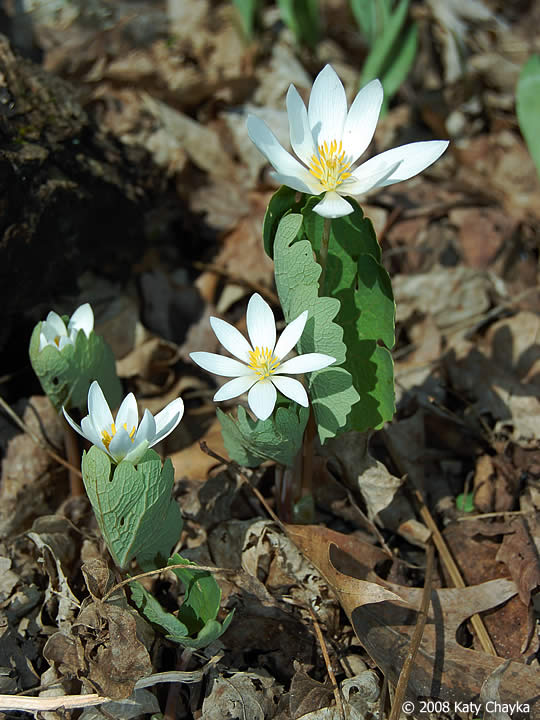
False Forget-Me-Not / Siberian Bugloss (Brunnera macrophylla)
Lately, the heart-shaped leaves of Brunnera have been getting more attention than it’s brilliant blue flowers. Several new cultivars of Brunnera have beautiful, creamy variegation. Whether you grow it for its flowers or foliage, this is an easy plant to care for.
Because Brunnera emerges so early in the spring, the leaves can get a bit tattered in summer. Simply cut them back and new leaves will fill in. Brunnera is a slow growing plant, but it will eventually form a nice size clump. The species and stabilized varieties may self-seed, but the variegated varieties are slower to spread.
Brunnera tends to be short-lived. To keep it around longer, divide the plants every 3 years or so. This will reinvigorate them.
Growing Conditions: Either plant Brunner in your shade garden or under the shade of nearby taller plants. The blue flowers are very early in the spring, so by the time something like a daylily starts to grow, it won’t hide the Brunnera flowers, it will just protect the leaves.
Exposure: As with so many spring bloomers, Brunnera can handle full sun in the spring, but it will do best in partial shade.

Lungwort (Pulmonaria)
Okay, it’s not the prettiest name, but it’s a fabulous early spring flower. As with Brunnera, Lungwort has beautiful flowers, but the emphasis lately has been on the flashy foliage. There are leaves that are dotted, speckled, and splashed with white and silver. Unfortunately, the plants tend to be ephemeral and fade away in the summer, but they’re center stage when you really need them.
The flowers hold their own intrigue. The white flowers remain clear white, while in bloom. But there are also flowers that start off pink and turn blue after they are pollinated. So you have two different color flowers on one plant.
Growing Conditions: Lungwort is a shade garden plant that prefers a rich soil. Give it plenty of compost when planted and side dress it every year to keep the soil rich and water retentive. Leaf mulch is a great choice to use with shade garden plants. It mimics the soil in a forest and it’s free.
Exposure: Partial shade to shade. Lungwort gives up quickly in hot sun.
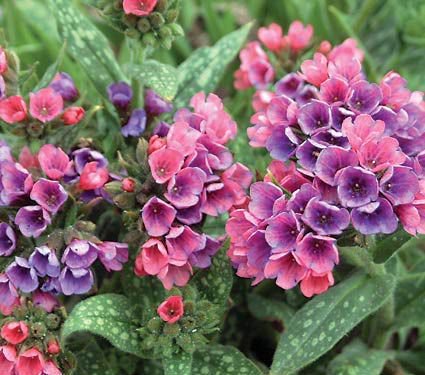
Creeping Phlox (Phlox subulata)
Creeping Phlox has probably caught your eye. It’s that carpet of flowers that seem to spill across spots on lawns or over rock walls. It’s usually planted in large masses, making a big splash that literally turns heads. Creeping Phlox comes in pastel shades of pink and lavender and well as a bolder hot pinks and clear white. The flowers don’t last terribly long, but they put on quite a show while they’re here.
Growing Conditions: Creeping phlox can handle poor growing conditions, providing it gets plenty of water. A richer soil will produce lusher plants. Whatever your soil quality, creeping phlox will need extra water during the summer, or it will easily get scorched.
Exposure: Full sun to partial shade. Creeping phlox flowers better in full sun, but the leaves stay fresher with a little afternoon shade.
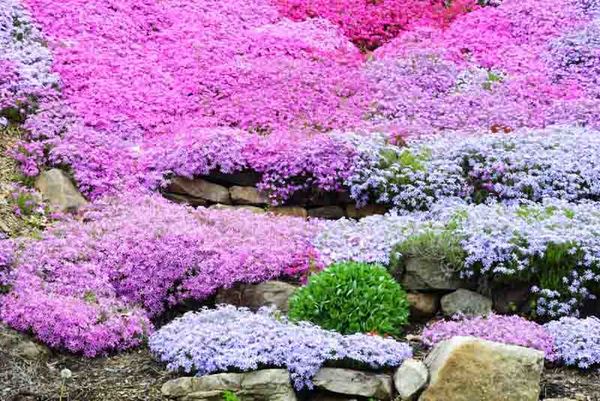
Pig Squeak – Bergenia cordifolia
Pig Squeak isn’t flashy, but it sure isn’t a wallflower, either. Its flowers may tiny, but there are plenty of them and they’re held high above the glossy, leathery leaves by burgundy stems. While Bergenia is an early spring bloomer, the leaves can stay good looking all season. In the fall, they turn a really nice bronze-red.
The species flowers are pink, but cultivars of Bergenia have been bred with white, red, and violet blooms. The plants spread by rhizomes, but not quickly enough to become a nuisance.It’s called pig squeak because that’s the sound it makes when you rub its leaves between your fingers. Try it. It’s guaranteed to make you laugh.
Growing Conditions: Pig Squeak plants need a rich, moist soil or they will languish. Don’t skimp on the compost and don’t plant them in a sunny dry spot.
Exposure: Full sun to partial shade. If you plant it in full sun, make sure your soil can hold moisture.
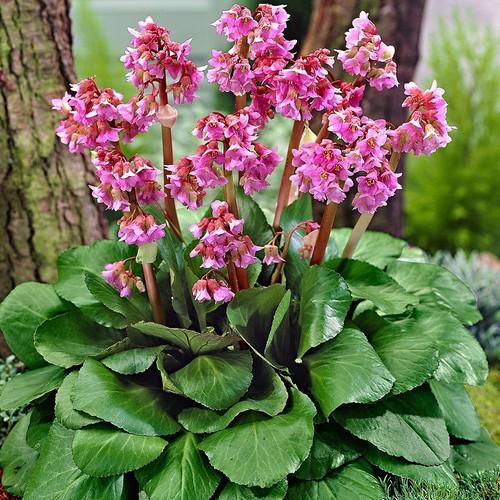
Primrose (Primula)
It’s hard to categorize primroses. There’s the common primrose (Primula vulgaris), cowslips (Primula veris) in buttery yellow, the exotic candelabras (Primula japonica) that hold their flower clusters on tall, straight stems, and the saturated colors of English primrose (Primula acaulis). They all vary a bit in shape and size, but they all look best in large clumps, particularly spreading out under trees.
Growing Conditions: Most primroses like a rich, moist soil and cool weather. In fact, some, like the candelabra primroses, can handle waterlogged soil.
Exposure: Full sun to partial shade. If you don’t have hot, hazy summers, you can plant them in full sun and expect maximum flowering. Where summer’s heat up, you’re better off planting them in partial shade.
Hardiness: USDA Hardiness Zones 3 to 9. Primroses need a winter chill to bloom their best.
Mature Size: 6 to 12 inches (h) s 8 to 12 inches (w)
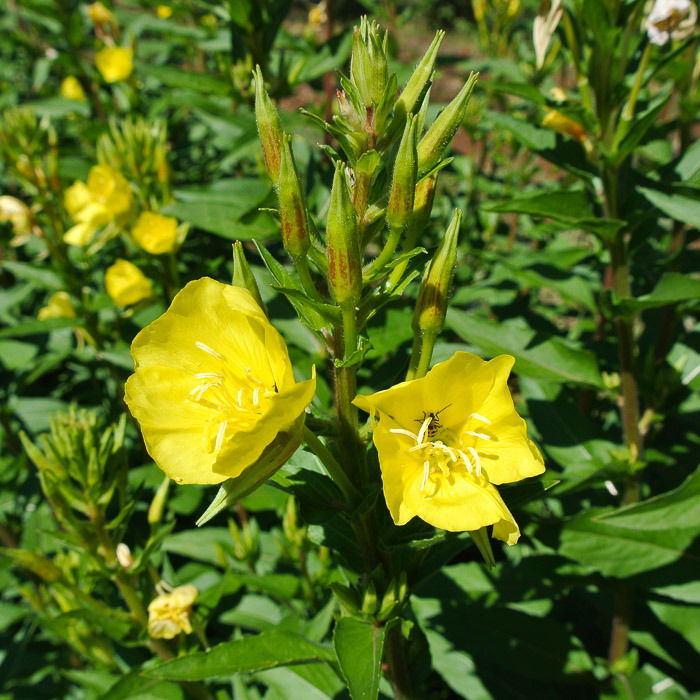
Solomon’s Seal (Polygonatum)
Solomon’s seal is eye-catching in a shade garden, with its arching stems and dangling flowers. Even post flower, the glossy black seed pods add eye appeal. Because it is a short plant that flowers downward, Solomon’s seal looks best in large swathes that can spread out naturally in your garden bed.
Solomon’s seal spreads by rhizomes, but not fast enough. Your friends will all want you to share this plant with them.
Growing Conditions: Solomon’s seal likes the same growing conditions of so many early spring plants – rich, moist soil. They don’t need a lot of sunshine to thrive.
Exposure: Partial shade. You’re really growing Solomon’s seal for its leaves and the shape of the plant. Growing it in sun will more than likely scorch the leaves.
Hardiness: USDA Hardiness Zones 3 to 9
Mature Size: 1 to 4 ft. (h) x 1 to 3 ft. (w). Most are low growing plants, but there are “Giant” Solomon’s seals (Polygonatum biflorum var. commutatum) that can actually get as tall as 5 ft.
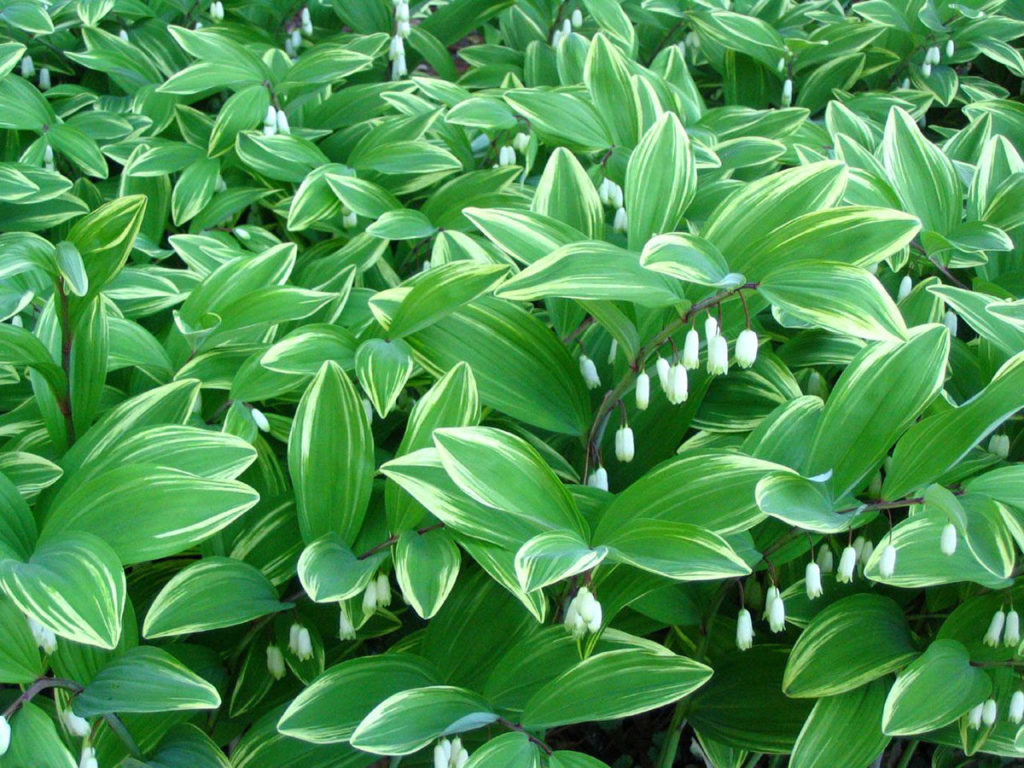
Virginia Bluebells (Mertensia virginica)
Poetry has been written about bluebells and many folks don’t think spring has arrived until they see them in bloom. Much like lungwort, the flowers don’t actually start out blue. They begin as pink buds and turn blue later. But there’s no denying their charm, with dangling clusters of tubular blue flowers.
Bluebells are yet another spring ephemeral, disappearing shortly after they flower. Don’t fret, they’ve done their job for the season and need the downtime to recover their strength. Besides, as they disappear, they make room for other plants to shine.
Growing Conditions: Bluebells need a rich, moist soil in the spring. They can handle a little bit drier soil in the summer when they’re dormant.
Exposure: Partial shade to shade. Don’t try to grow these in full unless your climate is cool and wet.
